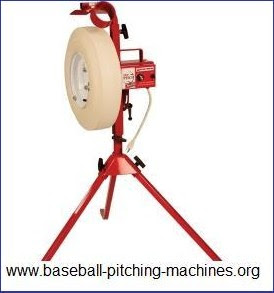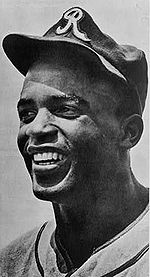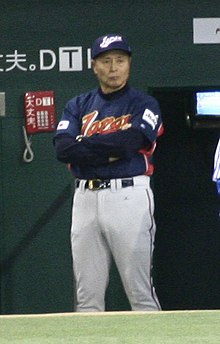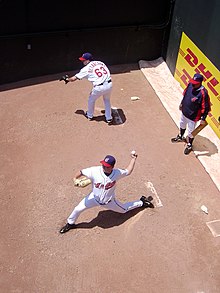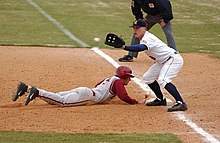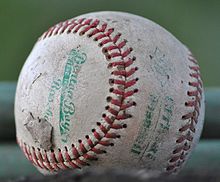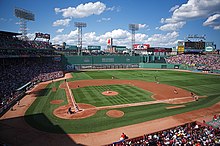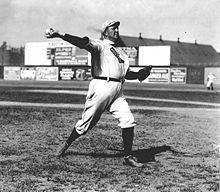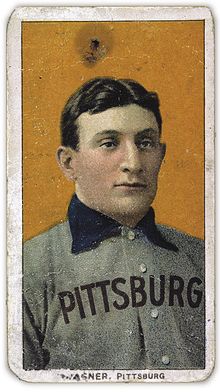 |
Interesting Facts About Baseball
NCBA - NC Baseball Association |
Baseball
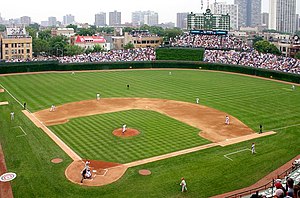
The baseball diamond at Wrigley Field, Chicago |
| First played | Mid-18th century or prior, England (early form)
June 19, 1846, Hoboken, New Jersey (first recorded game with codified rules) |
|---|
| Characteristics |
|---|
| Team members | 9 |
|---|
| Categorization | Bat-and-ball |
|---|
| Equipment | Baseball
Baseball bat
Baseball glove
Bases |
|---|
| Olympic | Demonstrated in 1912, 1936, 1952, 1956, 1964, 1984, and 1988 Summer Olympics
In Summer Olympic program, 1992–2008 |
|---|
Baseball is a
bat-and-ball sport played between two teams of nine players. The aim is to score
runs by hitting a thrown
ball with a
bat and touching a series of four
bases arranged at the corners of a 90-foot
diamond. Players on the
batting team take turns hitting against the
pitcher of the
fielding team, which tries to prevent runs by getting hitters
out in any of several ways. A player on the batting team can stop at any of the bases and later advance via a teammate's
hit or other means. The teams switch between batting and fielding whenever the fielding team records three outs. One turn at bat for each team constitutes an
inning and nine innings make up a professional game. The team with the most runs at the end of the game wins.
Evolving from older bat-and-ball games, an early form of baseball was being played in England by the mid-eighteenth century. This game was brought by immigrants to North America,
where the modern version developed. By the late nineteenth century, baseball was widely recognized as the
national sport of the United States. Baseball is now popular in North America, parts of Central and South America and the Caribbean, and parts of East Asia.
In the United States and Canada, professional
Major League Baseball (MLB) teams are divided into the
National League (NL) and
American League (AL), each with three divisions: East, West, and Central. The major league champion is determined by
playoffs that culminate in the
World Series. Five teams make the playoffs from each league: the three regular season division winners, plus two
wild card teams. Baseball is the leading team sport in both Japan and Cuba, and the top level of play is similarly split between two leagues: Japan's
Central League and
Pacific League; Cuba's
West League and East League. In the National and Central leagues, the pitcher is required to bat, per the traditional rules. In the American, Pacific, and both Cuban leagues, there is a tenth player, a
designated hitter, who bats for the pitcher. Each top-level team has a
farm system of one or more
minor league teams.
History
Origins of baseball
The evolution of baseball from older bat-and-ball games is difficult to trace with precision. A French manuscript from 1344 contains an illustration of clerics playing a game, possibly
la soule, with similarities to baseball.
[1] Other old French games such as
thèque,
la balle au bâton, and
la balle empoisonnée also appear to be related.
[2] Consensus once held that today's baseball is a North American development from the older game
rounders, popular in Great Britain and Ireland.
Baseball Before We Knew It: A Search for the Roots of the Game (2005), by David Block, suggests that the game originated in England; recently uncovered historical evidence supports this position. Block argues that rounders and early baseball were actually regional variants of each other, and that the game's most direct antecedents are the English games of
stoolball and "tut-ball".
[3] It has long been believed that
cricket also descended from such games, though evidence uncovered in early 2009 suggests that the sport may have been imported to England from
Flanders.
[4]
The earliest known reference to baseball is in a 1744 British publication,
A Little Pretty Pocket-Book, by
John Newbery. It contains a rhymed description of "base-ball" and a
woodcut that shows a field set-up somewhat similar to the modern game—though in a triangular rather than diamond configuration, and with posts instead of ground-level bases.
[5] William Bray, an English lawyer, recorded a game of baseball on Easter Monday 1755 in
Guildford,
Surrey.
[6] This early form of the game was apparently brought to North America by English immigrants. Rounders was also brought to the continent by both British and Irish immigrants. The first known American reference to baseball appears in a 1791
Pittsfield,
Massachusetts, town bylaw prohibiting the playing of the game near the town's new meeting house.
[7] By 1796, a version of the game was well-known enough to earn a mention in a German scholar's book on popular pastimes. As described by Johann Gutsmuths, "
englische Base-ball" involved a contest between two teams, in which "the batter has three attempts to hit the ball while at the home plate." Only one out was required to retire a side.
[8]

Alexander Cartwright, father of modern baseball
By the early 1830s, there were reports of a variety of uncodified bat-and-ball games recognizable as early forms of baseball being played around North America. These games were often referred to locally as "
town ball", though other names such as "round-ball" and "base-ball" were also used.
[9] Among the earliest examples to receive a detailed description—albeit five decades after the fact, in a letter from an attendee to
Sporting Life magazine—took place in Beachville,
Ontario, in 1838. There were many similarities to modern baseball, and some crucial differences: five bases (or
byes); first bye just 18 feet (5.5 m) from the home bye; batter out if a hit ball was caught after the first bounce.
[10] The
once widely accepted story that
Abner Doubleday invented baseball in
Cooperstown, New York, in 1839 has been conclusively debunked by sports historians.
[11]
In 1845,
Alexander Cartwright, a member of New York City's Knickerbockers club, led the codification of the so-called
Knickerbocker Rules.
[12] The practice, common to bat-and-ball games of the day, of "soaking" or "plugging"—effecting a
putout by hitting a runner with a thrown ball—was barred. The rules thus facilitated the use of a smaller, harder ball than had been common. Several other rules also brought the Knickerbockers' game close to the modern one, though a ball caught on the first bounce was, again, an out and only underhand pitching was allowed.
[13] While there are reports that the
New York Knickerbockers played games in 1845, the contest now recognized as the first officially recorded baseball game in U.S. history took place on June 19, 1846, in
Hoboken, New Jersey: the "New York Nine" defeated the Knickerbockers, 23–1, in four innings.
[14] With the Knickerbocker code as the basis, the rules of modern baseball continued to evolve over the next half-century.
[15]
History of baseball in the United States
The game turns professional
In the mid-1850s, a baseball craze hit the New York metropolitan area.
[16] By 1856, local journals were referring to baseball as the "national pastime" or "national game".
[17] A year later, sixteen area clubs formed the sport's first governing body, the
National Association of Base Ball Players. In 1863, the organization disallowed putouts made by catching a
fair ball on the first bounce. Four years later, it barred participation by
African Americans.
[18] The game's commercial potential was developing: in 1869 the first fully professional baseball club, the
Cincinnati Red Stockings, was formed and went undefeated against a schedule of semipro and amateur teams.
[19] The first professional league, the
National Association of Professional Base Ball Players, lasted from 1871 to 1875; scholars dispute
its status as a major league.
[20]
The more formally structured
National League was founded in 1876. As the oldest surviving major league, the National League is sometimes referred to as the "senior circuit".
[21] Several other major leagues formed and failed. In 1884, African American
Moses Walker (and, briefly, his brother Welday) played in one of these, the
American Association.
[22] An injury ended Walker's major league career, and by the early 1890s, a
gentlemen's agreement in the form of the
baseball color line effectively barred black players from the white-owned professional leagues, major and minor.
[23] Professional
Negro leagues formed, but quickly folded. Several independent African American teams succeeded as
barnstormers.
[24] Also in 1884, overhand pitching was legalized.
[25] In 1887,
softball, under the name of indoor baseball or indoor-outdoor, was invented as a winter version of the parent game.
[26] Virtually all of the modern baseball rules were in place by 1893; the last major change—counting
foul balls as
strikes—was instituted in 1901.
[25] The National League's first successful counterpart, the
American League, which evolved from the minor
Western League, was established that year.
[27] The two leagues, each with eight teams, were rivals that fought for the best players, often disregarding each other's contracts and engaging in bitter legal disputes.
[28]
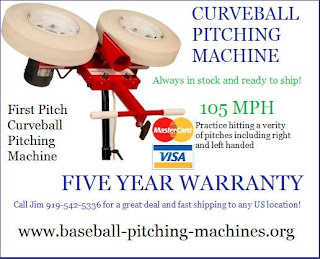 |
Always In Stock And Ready To Ship!
Call Jim 919-542-5336 for a great deal. |
A modicum of peace was eventually established, leading to the National Agreement of 1903. The pact formalized relations both between the two major leagues and between them and the National Association of Professional Base Ball Leagues, representing most of the country's
minor professional leagues.
[29] The
World Series, pitting the two major league champions against each other, was inaugurated that fall, albeit without express major league sanction: The
Boston Americans of the American League defeated the
Pittsburgh Pirates of the National League.
[30] The next year, the series was not held, as the National League champion
New York Giants, under
manager John McGraw, refused to recognize the major league status of the American League and its champion.
[31] In 1905, the Giants were National League champions again and team management relented, leading to the establishment of the World Series as the major leagues' annual championship event.
[32]
As professional baseball became increasingly profitable, players frequently raised grievances against owners over issues of control and equitable income distribution. During the major leagues' early decades, players on various teams occasionally attempted strikes, which routinely failed when their jobs were sufficiently threatened. In general, the strict rules of baseball contracts and the
reserve clause, which bound players to their teams even when their contracts had ended, tended to keep the players in check.
[33] Motivated by dislike for particularly stingy owner
Charles Comiskey and gamblers' payoffs, real and promised, members of the
Chicago White Sox conspired to
throw the
1919 World Series. The
Black Sox Scandal led to the formation of a new National Commission of baseball that drew the two major leagues closer together.
[34] The first
major league baseball commissioner,
Kenesaw Mountain Landis, was elected in 1920. That year also saw the founding of the
Negro National League; the first significant Negro league, it would operate until 1931. For part of the 1920s, it was joined by the
Eastern Colored League.
[35]
 |
The Original Model - Heavy Duty Combo
Call Jim 919-542-5336 for a great deal. |
Rise of Ruth and racial integration
Compared with the present, professional baseball in the early twentieth century was lower scoring and pitchers, the likes of
Walter Johnson and
Christy Mathewson, were more dominant. The "
inside game", which demanded that players "scratch for runs", was played much more aggressively than it is today: the brilliant and often violent
Ty Cobb epitomized this style.
[36] The so-called
dead-ball era ended in the early 1920s with several changes in rule and circumstance that were advantageous to hitters. Strict new regulations governing the ball's size, shape and composition, coupled with superior materials available after World War I, resulted in a ball that traveled farther when hit. The construction of additional seating to accommodate the rising popularity of the game often had the effect of bringing the outfield fences closer in, making
home runs more common.
[37] The rise of the legendary player
Babe Ruth, the first great power hitter of the new era, helped permanently alter the nature of the game. The club with which Ruth set most of his slugging records, the
New York Yankees, built a reputation as the majors' premier team.
[38] In the late 1920s and early 1930s,
St. Louis Cardinals general manager Branch Rickey invested in several
minor league clubs and developed the first modern "farm system".
[39] A new
Negro National League was organized in 1933; four years later, it was joined by the
Negro American League. The
first elections to the
Baseball Hall of Fame took place in 1936. In 1939
Little League Baseball was founded in Pennsylvania. By the late 1940s, it was the organizing body for
children's baseball leagues across the United States.
 |
Always In Stock And Ready To Ship
Call Jim 919-542-5336 for a great deal. |
With America's entry into World War II, many professional players had left to serve in the armed forces. A large number of minor league teams disbanded as a result and the major league game seemed under threat as well.
Chicago Cubs owner
Philip K. Wrigley led the formation of a new professional league with women players to help keep the game in the public eye – the
All-American Girls Professional Baseball League existed from 1943 to 1954.
[40] The inaugural
College World Series was held in 1947, and the Babe Ruth League youth program was founded. This program soon became another important organizing body for children's baseball. The first crack in the unwritten agreement barring blacks from white-controlled professional ball occurred the previous year:
Jackie Robinson was signed by the National League's
Brooklyn Dodgers—where Branch Rickey had become general manager—and began playing for their minor league team in Montreal.
[41] In 1947, Robinson broke the major leagues' color barrier when he debuted with the Dodgers.
Larry Doby debuted with the American League's
Cleveland Indians the same year.
[42] Latin American players, largely overlooked before, also started entering the majors in greater numbers. In 1951, two Chicago White Sox, Venezuelan-born
Chico Carrasquel and black Cuban-born
Minnie Miñoso, became the first Hispanic
All-Stars.
[43][44]
Facing competition as varied as television and
football, baseball attendance at all levels declined. While the majors rebounded by the mid-1950s, the minor leagues were gutted and hundreds of semipro and amateur teams dissolved.
[45][46] Integration proceeded slowly: by 1953, only six of the sixteen major league teams had a black player on the roster.
[43] That year, the
Major League Baseball Players Association was founded. It was the first professional baseball union to survive more than briefly, but it remained largely ineffective for years.
[47] No major league team had been located west of
St. Louis until 1958, when the Brooklyn Dodgers and New York Giants relocated to
Los Angeles and
San Francisco, respectively.
[48] The majors' final all-white bastion, the
Boston Red Sox, added a black player in 1959.
[43] With the integration of the majors drying up the available pool of players, the last Negro league folded the following year.
[49] In 1961, the American League reached the West Coast with the
Los Angeles Angels expansion team, and the major league season was extended from 154 games to 162. This coincidentally helped
Roger Maris break Babe Ruth's long-standing single-season home run record, one of the most celebrated marks in baseball.
[50] Along with the Angels, three other new franchises were launched during 1961–62. With this, the first major league expansion in sixty years, each league now had ten teams.
Attendance records and the age of steroids
The players' union became bolder under the leadership of former
United Steelworkers chief economist and negotiator
Marvin Miller, who was elected executive director in 1966.
[51] On the playing field, major league pitchers were becoming increasingly dominant again. After the 1968 season, in an effort to restore balance, the
strike zone was reduced and the height of the
pitcher's mound was lowered from 15 to 10 inches. In 1969, both the National and American leagues added two more expansion teams, the leagues were reorganized into two divisions each, and a post-season playoff system leading to the World Series was instituted. Also that same year,
Curt Flood of the St. Louis Cardinals made the first serious legal challenge to the reserve clause. The major leagues'
first general players' strike took place in 1972.
[52] In another effort to add more offense to the game, the American League adopted the
designated hitter rule the following year.
[53] In 1975, the union's power—and players' salaries—began to increase greatly when the reserve clause was
effectively struck down, leading to the
free agency system.
[54] In 1977, two more expansion teams joined the American League. Significant work stoppages occurred again in
1981 and
1994, the latter forcing the cancellation of the World Series for the first time in ninety years.
[55] Attendance had been growing steadily since the mid-1970s and in 1994, before the stoppage, the majors were setting their all-time record for per-game attendance.
[46][56]
 |
Five Year Head To Toe Factory Warranties
On All First Pitch Machines. |
The addition of two more expansion teams after the 1993 season had facilitated another restructuring of the major leagues, this time into three divisions each. Offensive production—the number of home runs in particular—had surged that year, and again in the abbreviated 1994 season.
[57] After play resumed in 1995, this trend continued and non-division-winning
wild card teams became a permanent fixture of the post-season. Regular-season
interleague play was introduced in 1997 and the second-highest attendance mark for a full season was set.
[58] The next year,
Mark McGwire and
Sammy Sosa both surpassed Maris's decades-old single season home run record and two more expansion franchises were added. In 2000, the National and American leagues were dissolved as legal entities. While their identities were maintained for scheduling purposes (and the designated hitter distinction), the regulations and other functions—such as player discipline and umpire supervision—they had administered separately were consolidated under the rubric of
Major League Baseball (MLB).
[59]
In 2001,
Barry Bonds established the current record of 73 home runs in a single season. There had long been suspicions that the dramatic increase in power hitting was fueled in large part by
the abuse of illegal steroids (as well as by the dilution of pitching talent due to expansion), but the issue only began attracting significant media attention in 2002 and there was no penalty for the use of performance-enhancing drugs before 2004.
[60] In 2007, Bonds became MLB's all-time home run leader, surpassing
Hank Aaron, as total major league and minor league attendance both reached all-time highs.
[61][62] Even though McGwire, Sosa, and Bonds—as well as many other players, including storied pitcher
Roger Clemens—have been implicated in the
steroid abuse scandal, their feats and those of other sluggers had become the major leagues' defining attraction.
[63] In contrast to the professional game's resurgence in popularity after the 1994 interruption, Little League enrollment was in decline: after peaking in 1996, it dropped 1 percent a year over the following decade.
[64] With more rigorous testing and penalties for performance-enhancing drug use a possible factor, the balance between bat and ball swung markedly in 2010, which became known as the "Year of the Pitcher".
[65] Runs per game fell to their lowest level in 18 years, and the strikeout rate was higher than it had been in half a century.
[66] Before the start of the 2012 season, MLB altered its rules to double the number of wild card teams admitted into the playoffs to two per league.
[67]
Baseball around the world
Baseball, widely known as America's pastime, is well established in several other countries as well. The history of baseball in Canada has remained closely linked with that of the sport in the United States. As early as 1877, a professional league, the International Association, featured teams from both countries.
[68] While baseball is widely played in Canada and many minor league teams have been based in the country, the American major leagues did not include a Canadian club until 1969, when the
Montreal Expos joined the National League as an expansion team. In 1977, the expansion
Toronto Blue Jays joined the American League. The Blue Jays won the World Series in 1992 and 1993, the first and still the only club from outside the United States to do so. After the 2004 season, Major League Baseball relocated the Expos to Washington, D.C., where the team is now known as the
Nationals.
 |
Call Me Jim 919-542-5336
For A Great Deal And Fast
Shipping On A New Baseball
Pitching Machine Today. |
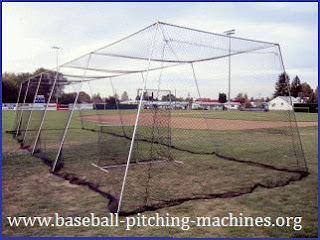 |
Portable Free Standing Batting Cages
Fast Shipping In The US Lower 48
Call Jim 919-542-533 for a great deal. |
In 1847, American soldiers played what may have been the first baseball game in Mexico at
Parque Los Berros in
Xalapa,
Veracruz. A few days after the
Battle of Zorro Gordo, they used the "wooden leg captured (by the Fourth Illinois regiment) from General
Santa Anna".
[69] The first formal baseball league outside of the United States and Canada was founded in 1878 in Cuba, which maintains a rich baseball tradition and whose national team has been one of the world's strongest since international play began in the late 1930s (all organized baseball in the country has officially been amateur since the
Cuban Revolution). The Dominican Republic held its first islandwide championship tournament in 1912.
[70] Professional baseball tournaments and leagues began to form in other countries between the world wars, including the Netherlands (formed in 1922), Australia (1934), Japan (1936), Mexico (1937), and Puerto Rico (1938).
[71] The
Japanese major leagues—the
Central League and
Pacific League—have long been considered the highest quality professional circuits outside of the United States.
[72] Japan has a professional minor league system as well, though it is much smaller than the American version—each team has only one farm club in contrast to MLB teams' four or five.
[73]
After World War II, professional leagues were founded in many Latin American nations, most prominently
Venezuela (1946) and the Dominican Republic (1955).
[74] Since the early 1970s, the annual
Caribbean Series has matched the championship clubs from the four leading Latin American winter leagues: the
Dominican Winter League,
Mexican Pacific League,
Puerto Rican Professional Baseball League, and
Venezuelan Professional Baseball League. In Asia,
South Korea (1982),
Taiwan (1990), and China (2003) all have professional leagues.
[75]
Many European countries have professional leagues as well, the most successful, other than the
Dutch league, being the
Italian league founded in 1948.
[76] Compared to those in Asia and Latin America, the various European leagues and the one in Australia historically have had no more than niche appeal. In 2004, Australia won a surprise silver medal at the
Olympic Games. The
Israel Baseball League, launched in 2007, folded after one season.
[77] The Confédération Européene de Baseball (European Baseball Confederation), founded in 1953, organizes a number of competitions between clubs from different countries, as well as national squads. Other competitions between national teams, such as the
Baseball World Cup and the
Olympic baseball tournament, have been administered by the
International Baseball Federation (IBAF) since its formation in 1938. By 2009, the IBAF had 117 member countries.
[78] Women's baseball is played on an organized amateur basis in many of the countries where it is a leading men's sport. Since 2004, the IBAF has sanctioned the
Women's Baseball World Cup, featuring national teams.
After being admitted to the Olympics as a
medal sport beginning with the
1992 Games, baseball was dropped from the
2012 Summer Olympic Games at the 2005
International Olympic Committee meeting. It remained part of the
2008 Games. The elimination of baseball, along with softball, from the 2012 Olympic program enabled the IOC to consider adding two different sports, but none received the votes required for inclusion.
[79] While the sport's lack of a following in much of the world was a factor, more important was Major League Baseball's reluctance to have a break during the Games to allow its players to participate, as the
National Hockey League now does during the
Winter Olympic Games. Such a break is more difficult for MLB to accommodate because it would force the playoffs deeper into cold weather.
[80] Seeking reinstatement for the
2016 Summer Olympics, the IBAF proposed an abbreviated competition designed to facilitate the participation of top players, but the effort failed.
[81] Major League Baseball initiated the
World Baseball Classic, scheduled to precede the major league season, partly as a replacement, high-profile international tournament. The
inaugural Classic, held in March 2006, was the first tournament involving national teams to feature a significant number of MLB participants.
[82] The Baseball World Cup was discontinued after its
2011 edition in favor of an expanded World Baseball Classic.
[83]
Rules and gameplay
Main article:
Baseball rules
A game is played between two teams, each composed of nine players, that take turns playing offense (
batting or hitting) and defense (fielding or pitching). A pair of turns, one at bat and one in the field, by each team constitutes an
inning. A game consists of nine innings. One team—customarily the visiting team—bats in the top, or first half, of every inning. The other team—customarily the home team—bats in the bottom, or second half, of every inning. The goal of the game is to score more points (
runs) than the other team. The players on the team at bat attempt to score runs by circling or completing a tour of the four bases set at the corners of the square-shaped
baseball diamond. A player bats at
home plate and must proceed
counterclockwise to first base, second base, third base, and back home in order to score a run. The team in the field attempts both to prevent runs from scoring and to record
outs, which remove opposing players from offensive action until their turn in their team's
batting order comes up again. When three outs are recorded, the teams switch roles for the next half-inning. If the score of the game is tied after nine innings,
extra innings are played to resolve the contest. Many amateur games, particularly unorganized ones, involve different numbers of players and innings.
[84]
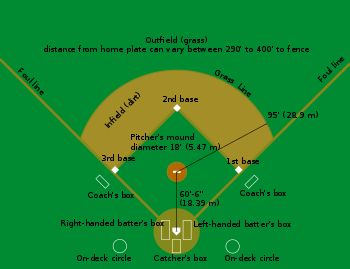
Diagram of a
baseball field (the term
diamond may be used to refer to the square area defined by the four bases or to the entire playing field). The dimensions given are for professional and professional-style games. Children often play on smaller fields.
The game is played on a field whose primary boundaries, the foul lines, extend forward from home plate at 45-degree angles. The 90-degree area within the foul lines is referred to as fair territory; the 270-degree area outside them is foul territory. The part of the field enclosed by the bases and several yards beyond them is the
infield; the area farther beyond the infield is the
outfield. In the middle of the infield is a raised pitcher's mound, with a rectangular rubber plate (the rubber) at its center. The outer boundary of the outfield is typically demarcated by a raised fence, which may be of any material and height (many amateur games are played on unfenced fields). Fair territory between home plate and the outfield boundary is baseball's field of play, though significant events can take place in foul territory, as well.
[85]
There are three basic tools of baseball: the
ball, the
bat, and the
glove or mitt:
- The baseball is about the size of an adult's fist, around 9 inches (23 centimeters) in circumference. It has a rubber or cork center, wound in yarn and covered in white cowhide, with red stitching.[86]
- The bat is a hitting tool, traditionally made of a single, solid piece of wood. Other materials are now commonly used for nonprofessional games. It is a hard round stick, about 2.5 inches (6.4 centimeters) in diameter at the hitting end, tapering to a narrower handle and culminating in a knob. Bats used by adults are typically around 34 inches (86 centimeters) long, and not longer than 42 inches (106 centimeters).[87]
- The glove or mitt is a fielding tool, made of padded leather with webbing between the fingers. As an aid in catching and holding onto the ball, it takes various shapes to meet the specific needs of different fielding positions.[88]
Protective helmets are also standard equipment for all batters.
[89]
At the beginning of each half-inning, the nine players on the fielding team arrange themselves around the field. One of them, the
pitcher, stands on the pitcher's mound. The pitcher begins the pitching delivery with one foot on the rubber, pushing off it to gain velocity when throwing toward home plate. Another player, the
catcher, squats on the far side of home plate, facing the pitcher. The rest of the team faces home plate, typically arranged as four infielders—who set up along or within a few yards outside the imaginary lines between first, second, and third base—and three outfielders. In the
standard arrangement, there is a
first baseman positioned several steps to the left of first base, a
second baseman to the right of second base, a
shortstop to the left of second base, and a
third baseman to the right of third base. The basic outfield positions are
left fielder,
center fielder, and
right fielder. A neutral
umpire sets up behind the catcher.
[90] Other umpires will be distributed around the field as well, though the number will vary depending on the level of play, amateur or children's games may only have an umpire behind the plate, while as many as six umpires can be used for important Major League Baseball games.
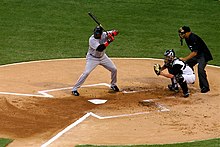
Awaiting a pitch: batter, catcher, and umpire
Play starts with a batter standing at home plate, holding a bat.
[91] The batter waits for the pitcher to throw a pitch (the ball) toward home plate, and attempts to hit the ball
[92] with the bat.
[91] The catcher catches pitches that the batter does not hit—as a result of either electing not to swing or failing to connect—and returns them to the pitcher. A batter who hits the ball into the field of play must drop the bat and begin running toward first base, at which point the player is referred to as a
runner (or, until the play is over, a
batter-runner). A batter-runner who reaches first base without being
put out (see below) is said to be
safe and is now on base. A batter-runner may choose to remain at first base or attempt to advance to second base or even beyond—however far the player believes can be reached safely. A player who reaches base despite proper play by the fielders has recorded a
hit. A player who reaches first base safely on a hit is credited with a
single. If a player makes it to second base safely as a direct result of a hit, it is a
double; third base, a
triple. If the ball is hit in the air within the foul lines over the entire outfield (and outfield fence, if there is one), it is a
home run: the batter and any runners on base may all freely circle the bases, each scoring a run. This is the most desirable result for the batter. A player who reaches base due to a fielding mistake is not credited with a hit—instead, the responsible fielder is charged with an
error.
[91]
Any runners already on base may attempt to advance on batted balls that land, or contact the ground, in fair territory, before or after the ball lands. A runner on first base
must attempt to advance if a ball lands in play. If a ball hit into play rolls foul before passing through the infield, it becomes
dead and any runners must return to the base they were at when the play began. If the ball is hit in the air and caught before it lands, the batter has
flied out and any runners on base may attempt to advance only if they
tag up or touch the base they were at when the play began, as or after the ball is caught. Runners may also attempt to advance to the next base while the pitcher is in the process of delivering the ball to home plate—a successful effort is a
stolen base.
[93]
A pitch that is not hit into the field of play is called either a strike or a ball. A batter against whom three strikes are recorded
strikes out. A batter against whom four balls are recorded is awarded a
base on balls or walk, a free advance to first base. (A batter may also freely advance to first base if the batter's body or uniform is struck by a pitch outside the strike zone, provided the batter does not swing and attempts to avoid being hit.)
[94] Crucial to determining balls and strikes is the umpire's judgment as to whether a pitch has passed through the
strike zone, a conceptual area above home plate extending from the midpoint between the batter's shoulders and belt down to the hollow of the knee.
[95]
A strike is called when one of the following happens:
- The batter lets a well-pitched ball (one within the strike zone) go through to the catcher.
- The batter swings at any ball (even one outside the strike zone) and misses, or foul tips it directly into the catcher's hands.
- The batter hits a foul ball—one that either initially lands in foul territory or initially lands within the diamond but moves into foul territory before passing first or third base. If there are already two strikes on the batter, a foul ball is not counted as a third strike; thus, a foul ball cannot result in the immediate strikeout of the batter. (There is an exception to this exception: a two-strike foul bunt is recorded as a third strike.)
A ball is called when the pitcher throws a pitch that is outside the strike zone, provided the batter has not swung at it.
[95][96]
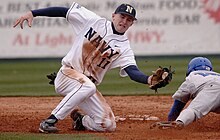
A
shortstop tries to
tag out a runner who is sliding headfirst, attempting to reach second base.
While the team at bat is trying to score runs, the team in the field is attempting to record outs. Among the various ways a member of the batting team may be put out, five are most common:
- The strikeout: as described above, recorded against a batter who makes three strikes before putting the ball into play or being awarded a free advance to first base.
- The flyout: as described above, recorded against a batter who hits a ball in the air that is caught by a fielder, whether in fair territory or foul territory, before it lands, whether or not the batter has run.
- The ground out: recorded against a batter (in this case, batter-runner) who hits a ball that lands in fair territory which, before the batter-runner can reach first base, is retrieved by a fielder who touches first base while holding the ball or relays it to another fielder who touches first base while holding the ball.
- The force out: recorded against a runner who is required to attempt to advance—either because the runner is on first base and a batted ball lands in fair territory, or because the runner immediately behind on the basepath is thus required to attempt to advance—but fails to reach the next base before a fielder touches the base while holding the ball. The ground out is technically a special case of the force out.
- The tag out: recorded against a runner who is touched by a fielder with the ball or a glove holding the ball, while the runner is not touching a base.
It is possible to record two outs in the course of the same play—a
double play. Even three—a
triple play—is possible, though this is very rare. Players put out or retired must leave the field, returning to their team's
dugout or bench. A runner may be stranded on base when a third out is recorded against another player on the team. Stranded runners do not benefit the team in its next turn at bat—every half-inning begins with the bases empty of runners.
[97]
An individual player's turn batting or
plate appearance is complete when the player reaches base, hits a home run, makes an out, or hits a ball that results in the team's third out, even if it is recorded against a teammate. On rare occasions, a batter may be at the plate when, without the batter's hitting the ball, a third out is recorded against a teammate—for instance, a runner getting
caught stealing (tagged out attempting to steal a base). A batter with this sort of incomplete plate appearance starts off the team's next turn batting; any balls or strikes recorded against the batter the previous inning are erased. A runner may circle the bases only once per plate appearance and thus can score at most a single run per batting turn. Once a player has completed a plate appearance, that player may not bat again until the eight other members of the player's team have all taken their turn at bat. The batting order is set before the game begins, and may not be altered except for substitutions. Once a player has been removed for a substitute, that player may not reenter the game. Children's games often have more liberal substitution rules.
[98]
If the
designated hitter (DH) rule is in effect, each team has a tenth player whose sole responsibility is to bat (and run). The DH takes the place of another player—almost invariably the pitcher—in the batting order, but does not field. Thus, even with the DH, each team still has a batting order of nine players and a fielding arrangement of nine players.
[99]
Personnel
Player rosters
Roster, or squad, sizes differ between different leagues and different levels of organized play. Major League Baseball teams maintain 25-player active rosters. A typical 25-man roster in a league without the DH rule, such as MLB's National League, features:
[100]
- eight position players—catcher, four infielders, three outfielders—who play on a regular basis
- five starting pitchers who constitute the team's pitching rotation or starting rotation
- six relief pitchers, including one specialist closer, who constitute the team's bullpen (named for the off-field area where pitchers warm up)
- one backup, or substitute, catcher
- two backup infielders
- two backup outfielders
- one specialist pinch hitter, or a second backup catcher, or a seventh reliever
Other personnel
The
manager, or head coach of a team, oversees the team's major strategic decisions, such as establishing the starting rotation, setting the lineup, or batting order, before each game, and making substitutions during games—in particular, bringing in relief pitchers. Managers are typically assisted by two or more
coaches; they may have specialized responsibilities, such as working with players on hitting, fielding, pitching, or strength and conditioning. At most levels of organized play, two coaches are stationed on the field when the team is at bat: the first base coach and third base coach, occupying designated coaches' boxes just outside the foul lines, assist in the direction of baserunners when the ball is in play, and relay tactical signals from the manager to batters and runners during pauses in play.
[101] In contrast to many other team sports, baseball managers and coaches generally wear their team's uniforms; coaches must be in uniform in order to be allowed on the playing field during a game.
[102]
Any baseball game involves one or more
umpires, who make rulings on the outcome of each play. At a minimum, one umpire will stand behind the catcher, to have a good view of the strike zone, and call balls and strikes. Additional umpires may be stationed near the other bases, thus making it easier to judge plays such as attempted force outs and tag outs. In Major League Baseball, four umpires are used for each game, one near each base. In the playoffs, six umpires are used: one at each base and two in the outfield along the foul lines.
[103]
Strategy and tactics
Many of the pre-game and in-game strategic decisions in baseball revolve around a fundamental fact: in general, right-handed batters tend to be more successful against left-handed pitchers and, to an even greater degree, left-handed batters tend to be more successful against right-handed pitchers.
[104] A manager with several left-handed batters in the regular lineup who knows the team will be facing a left-handed starting pitcher may respond by starting one or more of the right-handed backups on the team's roster. During the late innings of a game, as relief pitchers and pinch hitters are brought in, the opposing managers will often go back and forth trying to create favorable matchups with their substitutions: the manager of the fielding team trying to arrange same-handed pitcher-batter matchups, the manager of the batting team trying to arrange opposite-handed matchups. With a team that has the lead in the late innings, a manager may remove a starting position player—especially one whose turn at bat is not likely to come up again—for a more skillful fielder.
[105]
Pitching and fielding tactics
The tactical decision that precedes almost every play in a baseball game involves pitch selection. Among the wide variety of pitches that may be thrown, the four basic types are the
fastball, the
changeup (or off-speed pitch), and two
breaking balls—the
curveball and the
slider.
[106] Pitchers have different repertoires of pitches they are skillful at throwing. Conventionally, before each pitch, the catcher signals the pitcher what type of pitch to throw, as well as its general vertical and/or horizontal location.
[107] If there is disagreement on the selection, the pitcher may
shake off the sign and the catcher will call for a different pitch. With a runner on base and
taking a lead, the pitcher may attempt a
pickoff, a quick throw to a fielder
covering the base to keep the runner's lead in check or, optimally, effect a tag out. If an attempted stolen base is anticipated, the catcher may call for a
pitchout, a ball thrown deliberately off the plate, allowing the catcher to catch it while standing and throw quickly to a base.
[108] Facing a batter with a strong tendency to hit to one side of the field, the fielding team may employ a
shift, with most or all of the fielders moving to the left or right of their usual positions. With a runner on third base, the infielders may
play in, moving closer to home plate to improve the odds of throwing out the runner on a
ground ball, though a sharply hit grounder is more likely to carry through a drawn-in infield.
[109]
Batting and baserunning tactics

A batter squares to bunt, moving his hands up the barrel of the bat to increase his control and deaden the ball on impact.
Several basic offensive tactics come into play with a runner on first base, including the fundamental choice of whether to attempt a steal of second base. The
hit and run is sometimes employed with a skillful
contact hitter: the runner takes off with the pitch drawing the shortstop or second baseman over to second base, creating a gap in the infield for the batter to poke the ball through.
[110] The
sacrifice bunt calls for the batter to focus on making contact with the ball so that it rolls a short distance into the infield, allowing the runner to advance into
scoring position even at the expense of the batter being thrown out at first—a batter who succeeds is credited with a sacrifice. (A batter, particularly one who is a fast runner, may also attempt to
bunt for a hit.) A sacrifice bunt employed with a runner on third base, aimed at bringing that runner home, is known as a
squeeze play.
[111] With a runner on third and fewer than two outs, a batter may instead concentrate on hitting a fly ball that, even if it is caught, will be deep enough to allow the runner to tag up and score—a successful batter in this case gets credit for a
sacrifice fly.
[109] The manager will sometimes signal a batter who is
ahead in the count (i.e., has more balls than strikes) to
take, or not swing at, the next pitch.
[112]
Distinctive elements
Baseball has certain attributes that set it apart from the other popular team sports in the countries where it has a following, games such as
American and
Canadian football,
basketball,
ice hockey, and
soccer. All of these sports use a clock; in all of them, play is less individual and more collective; and in none of them is the variation between playing fields nearly as substantial or important. The
comparison between cricket and baseball demonstrates that many of baseball's distinctive elements are shared in various ways with its cousin sport.
No clock to kill
In clock-limited sports, games often end with a team that holds the lead
killing the clock rather than competing aggressively against the opposing team. In contrast, baseball has no clock; a team cannot win without getting the last batter out and rallies are not constrained by time. At almost any turn in any baseball game, the most advantageous strategy is some form of aggressive strategy.
[113] In contrast, again, the clock comes into play even in the case of multi-day
Test and
first-class cricket: the possibility of a draw often encourages a team that is batting last and well behind to bat defensively, giving up any faint chance at a win to avoid a loss.
[114] Baseball offers no such reward for conservative batting.
While nine innings has been the standard since the beginning of professional baseball, the duration of the average major league game has increased steadily through the years. At the turn of the twentieth century, games typically took an hour and a half to play. In the 1920s, they averaged just less than two hours, which eventually ballooned to 2:38 in 1960.
[115] By 1997, the average American League game lasted 2:57 (National League games were about 10 minutes shorter—pitchers at the plate making for quicker outs than designated hitters).
[116] In 2004, Major League Baseball declared that its goal was an average game of merely 2:45.
[115] The lengthening of games is attributed to longer breaks between half-innings for television commercials, increased offense, more pitching changes, and a slower pace of play with pitchers taking more time between each delivery, and batters stepping out of the box more frequently.
[115][116] Other leagues have experienced similar issues. In 2008,
Nippon Professional Baseball took steps aimed at shortening games by 12 minutes from the preceding decade's average of 3:18.
[117]
Individual focus
For a team sport, baseball places individual players under unusual scrutiny and pressure. In 1915, a baseball instructional manual pointed out that every single pitch, of which there are often more than two hundred in a game, involves an individual, one-on-one contest: "the pitcher and the batter in a battle of wits".
[118] Contrasting the game with both football and basketball, scholar Michael Mandelbaum argues that "baseball is the one closest in evolutionary descent to the older individual sports".
[119] Pitcher, batter, and fielder all act essentially independent of each other. While coaching staffs can signal pitcher or batter to pursue certain tactics, the execution of the play itself is a series of solitary acts. If the batter hits a line drive, the outfielder is solely responsible for deciding to try to catch it or play it on the bounce and for succeeding or failing. The statistical precision of baseball is both facilitated by this isolation and reinforces it. As described by Mandelbaum,
It is impossible to isolate and objectively assess the contribution each [football] team member makes to the outcome of the play.... [E]very basketball player is interacting with all of his teammates all the time. In baseball, by contrast, every player is more or less on his own.... Baseball is therefore a realm of complete transparency and total responsibility. A baseball player lives in a glass house, and in a stark moral universe.... Everything that every player does is accounted for and everything accounted for is either good or bad, right or wrong.[120]
Cricket is more similar to baseball than many other team sports in this regard: while the individual focus in cricket is mitigated by the importance of the
batting partnership and the practicalities of tandem running, it is enhanced by the fact that a batsman may occupy the
wicket for an hour or much more. There is no statistical equivalent in cricket for the fielding error and thus less emphasis on personal responsibility in this area of play.
[121]
Uniqueness of each baseball park
Main article:
Baseball park
Unlike those of most sports, baseball playing fields can vary significantly in size and shape. While the dimensions of the infield are specifically regulated, the only constraint on outfield size and shape for professional teams following the rules of Major League and Minor League Baseball is that fields built or remodeled since June 1, 1958, must have a minimum distance of 325 feet (99 m) from home plate to the fences in left and right field and 400 feet (122 m) to center.
[122] Major league teams often skirt even this rule. For example, at
Minute Maid Park, which became the home of the
Houston Astros in 2000, the
Crawford Boxes in left field are only 315 feet (96 m) from home plate.
[123] There are no rules at all that address the height of fences or other structures at the edge of the outfield. The most famously idiosyncratic outfield boundary is the left-field wall at Boston's
Fenway Park, in use since 1912: the
Green Monster is 310 feet (94 m) from home plate down the line and 37 feet (11 m) tall.
[124]
Similarly, there are no regulations at all concerning the dimensions of foul territory. Thus a foul fly ball may be entirely out of play in a park with little space between the foul lines and the stands, but a flyout in a park with more expansive foul ground.
[125] A fence in foul territory that is close to the outfield line will tend to direct balls that strike it back toward the fielders, while one that is farther away may actually prompt more collisions, as outfielders run full speed to field balls deep in the corner. These variations can make the difference between a double and a triple or
inside-the-park home run.
[126] The surface of the field is also unregulated. While the image to the left shows a traditional field surfacing arrangement (and the one used by virtually all MLB teams with naturally surfaced fields), teams are free to decide what areas will be grassed or bare.
[127] Some fields—including several in MLB—use an artificial surface, such as
AstroTurf. Surface variations can have a significant effect on how ground balls behave and are fielded as well as on baserunning. Similarly, the presence of a roof (seven major league teams play in stadiums with permanent or retractable roofs) can greatly affect how fly balls are played.
[128] While football and soccer players deal with similar variations of field surface and stadium covering, the size and shape of their fields are much more standardized. The area out-of-bounds on a football or soccer field does not affect play the way foul territory in baseball does, so variations in that regard are largely insignificant.
[129]
These physical variations create a distinctive set of playing conditions at each ballpark. Other local factors, such as altitude and climate, can also significantly affect play. A given stadium may acquire a reputation as a pitcher's park or a hitter's park, if one or the other discipline notably benefits from its unique mix of elements. The most exceptional park in this regard is
Coors Field, home of the
Colorado Rockies. Its high altitude—5,282 feet (1,610 m) above sea level—is responsible for giving it the strongest hitter's park effect in the major leagues.
[130] Wrigley Field, home of the
Chicago Cubs, is known for its fickle disposition: a hitter's park when the strong winds off
Lake Michigan are blowing out, it becomes more of a pitcher's park when they are blowing in.
[131] The absence of a standardized field affects not only how particular games play out, but the nature of team rosters and players' statistical records. For example, hitting a fly ball 330 feet (100 m) into right field might result in an easy catch on the
warning track at one park, and a home run at another. A team that plays in a park with a relatively short right field, such as the New York Yankees, will tend to stock its roster with left-handed
pull hitters, who can best exploit it. On the individual level, a player who spends most of his career with a team that plays in a hitter's park will gain an advantage in batting statistics over time—even more so if his talents are especially suited to the park.
[132]
Statistics
Organized baseball lends itself to
statistics to a greater degree than many other sports. Each play is discrete and has a relatively small number of possible outcomes. In the late nineteenth century, a former cricket player, English-born
Henry Chadwick of
Brooklyn, New York, was responsible for the "development of the
box score, tabular standings, the annual baseball guide, the
batting average, and most of the common statistics and tables used to describe baseball."
[133] The statistical record is so central to the game's "historical essence" that Chadwick came to be known as Father Baseball.
[133] In the 1920s, American newspapers began devoting more and more attention to baseball statistics, initiating what journalist and historian
Alan Schwarz describes as a "tectonic shift in sports, as intrigue that once focused mostly on teams began to go to individual players and their statistics lines."
[134]
The Official Baseball Rules administered by Major League Baseball require the
official scorer to categorize each baseball play unambiguously. The rules provide detailed criteria to promote consistency. The
score report is the official basis for both the box score of the game and the relevant statistical records.
[135] General managers, managers, and
baseball scouts use statistics to evaluate players and make strategic decisions.
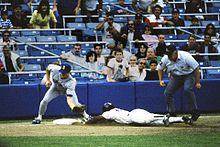
Rickey Henderson—the major leagues' all-time leader in runs and stolen bases—stealing third base in a 1988 game.
Certain traditional statistics are familiar to most baseball fans. The basic batting statistics include:
[136]
- At bats: plate appearances, excluding walks and hit by pitches—where the batter's ability is not fully tested—and sacrifices and sacrifice flies—where the batter intentionally makes an out in order to advance one or more baserunners
- Hits: times reached base because of a batted, fair ball without fielding error or fielder's choice
- Runs: times circling the bases and reaching home safely
- Runs batted in (RBIs): number of runners who scored due to a batter's action (including the batter, in the case of a home run), except when batter grounded into double play or reached on an error
- Home runs: hits on which the batter successfully touched all four bases, without the contribution of a fielding error
- Batting average: hits divided by at bats—the traditional measure of batting ability
The basic baserunning statistics include:
[137]
- Stolen bases: times advancing to the next base entirely due to the runner's own efforts, generally while the pitcher is preparing to deliver or delivering the ball
- Caught stealing: times tagged out while attempting to steal a base
The basic pitching statistics include:
[138]
- Wins: credited to pitcher on winning team who last pitched before the team took a lead that it never relinquished (a starting pitcher must pitch at least five innings to qualify for a win)
- Losses: charged to pitcher on losing team who was pitching when the opposing team took a lead that it never relinquished
- Saves: games where the pitcher enters a game led by the pitcher's team, finishes the game without surrendering the lead, is not the winning pitcher, and either (a) the lead was three runs or less when the pitcher entered the game; (b) the potential tying run was on base, at bat, or on deck; or (c) the pitcher pitched three or more innings.
- Innings pitched: outs recorded while pitching divided by three
- Strikeouts: times pitching three strikes to a batter
- Winning percentage: wins divided by decisions (wins plus losses)
- Earned run average (ERA): runs allowed, excluding those resulting from fielding errors, per nine innings pitched
The basic fielding statistics include:
[139]
- Putouts: times the fielder catches a fly ball, tags or forces out a runner, or otherwise directly effects an out
- Assists: times a putout by another fielder was recorded following the fielder touching the ball
- Errors: times the fielder fails to make a play that should have been made with common effort, and the batting team benefits as a result
- Total chances: putouts plus assists plus errors
- Fielding average: successful chances (putouts plus assists) divided by total chances
Among the many other statistics that are kept are those collectively known as
situational statistics. For example, statistics can indicate which specific pitchers a certain batter performs best against. If a given situation statistically favors a certain batter, the manager of the fielding team may be more likely to change pitchers or have the pitcher
intentionally walk the batter in order to face one who is less likely to succeed.
[140]
Sabermetrics
Sabermetrics refers to the field of baseball statistical study and the development of new statistics and analytical tools. The term is also used to refer directly to new statistics themselves. The term was coined around 1980 by one of the field's leading proponents,
Bill James, and derives from the
Society for American Baseball Research (SABR).
[141]
The growing popularity of biometrics's since the early 1980s has brought more attention to two batting statistics that sabermetricians argue are much better gauges of a batter's skill than batting average:
[142]
- On-base percentage measures a batter's ability to get on base. It is calculated by taking the sum of the batter's successes in getting on base (hits plus walks plus hit by pitches) and dividing that by the batter's total plate appearances (at bats plus walks plus hit by pitches plus sacrifice flies), except for sacrifice bunts.[143]
- Slugging percentage measures a batter's ability to hit for power. It is calculated by taking the batter's total bases (one per each single, two per double, three per triple, and four per home run) and dividing that by the batter's at bats.[144]
Some of the new statistics devised by sabermetricians have gained wide use:
- On-base plus slugging (OPS) measures a batter's overall ability. It is calculated by adding the batter's on-base percentage and slugging percentage.[145]
Popularity and cultural impact
Writing in 1919, philosopher
Morris Raphael Cohen described baseball as America's national religion.
[147] In the words of sports columnist
Jayson Stark, baseball has long been "a unique paragon of American culture"—a status he sees as devastated by the steroid abuse scandal.
[148] Baseball has an important place in other national cultures as well: Scholar Peter Bjarkman describes "how deeply the sport is ingrained in the history and culture of a nation such as Cuba, [and] how thoroughly it was radically reshaped and nativized in Japan."
[149] Since the early 1980s, the Dominican Republic, in particular the city of
San Pedro de Macorís, has been the major leagues' primary source of foreign talent.
[150] Hall-of-Famer
Roberto Clemente remains one of the greatest national heroes in Puerto Rico's history.
[151] While baseball has long been the island's primary athletic pastime, its once well-attended professional winter league has declined in popularity since 1990, when young Puerto Rican players began to be included in the major leagues' annual first-year player draft.
[152] In the Western Hemisphere, baseball is also one of the leading sports in Canada,
Colombia, Mexico, the
Netherlands Antilles,
Nicaragua,
Panama, and Venezuela. In Asia, it is among the most popular sports in South Korea and Taiwan.
The major league game in the United States was originally targeted toward a middle-class, white-collar audience: relative to other spectator pastimes, the National League's set ticket price of 50 cents in 1876 was high, while the location of playing fields outside the inner city and the workweek daytime scheduling of games were also obstacles to a blue-collar audience.
[153] A century later, the situation was very different. With the rise in popularity of other team sports with much higher average ticket prices—football, basketball, and hockey—professional baseball had become among the most blue-collar-oriented of leading American spectator sports.
[154]
In the late 1900s and early 2000s, baseball's position compared to football in the United States moved in contradictory directions. In 2008, Major League Baseball set a revenue record of $6.5 billion, matching the NFL's revenue for the first time in decades.
[155] A new MLB revenue record of $6.6 billion was set in 2009.
[156] On the other hand, the percentage of American sports fans polled who named baseball as their favorite sport was 16%, compared to pro football at 31%. In 1985, the respective figures were pro football 24%, baseball 23%.
[157] Because there are so many more major league baseball games played, there is no comparison in overall attendance. In 2008, total attendance at major league games was the second-highest in history: 78.6 million, 0.7% off the record set the previous year.
[61] The following year, amid the U.S. recession, attendance fell by 6.6% to 73.4 million.
[156] Attendance at games held under the
Minor League Baseball umbrella also set a record in 2007, with 42.8 million;
[62] this figure does not include attendance at games of the several independent minor leagues.
In Japan, where baseball is inarguably the leading spectator team sport, combined revenue for the twelve teams in
Nippon Professional Baseball (NPB), the body that oversees both the Central and Pacific leagues, was estimated at $1 billion in 2007. Total NPB attendance for the year was approximately 20 million. While in the preceding two decades, MLB attendance grew by 50 percent and revenue nearly tripled, the comparable NPB figures were stagnant. There are concerns that MLB's growing interest in acquiring star Japanese players will hurt the game in their home country.
[73] In Cuba, where baseball is by every reckoning the national sport,
[158] the national team overshadows the city and provincial teams that play in the top-level domestic leagues.
[159] Revenue figures are not released for the country's amateur system. Similarly, according to one official pronouncement, the sport's governing authority "has never taken into account attendance ... because its greatest interest has always been the development of athletes".
[160]
As of 2007, Little League Baseball oversees more than 7,000 children's baseball leagues with more than 2.2 million participants—2.1 million in the United States and 123,000 in other countries.
[161] Babe Ruth League teams have over 1 million participants.
[162] According to the president of the International Baseball Federation, between 300,000 and 500,000 women and girls play baseball around the world, including Little League and the introductory game of
Tee Ball.
[163]
A varsity baseball team is an established part of
physical education departments at most high schools and colleges in the United States. In 2008, nearly half a million high schoolers and over 35,000 collegians played on their schools' baseball teams.
[161] The number of Americans participating in baseball has declined since the late 1980s, falling well behind the number of soccer participants.
[164] By early in the 20th century, intercollegiate baseball was Japan's leading sport. Today,
high school baseball in particular is immensely popular there.
[165] The final rounds of the two annual tournaments—the
National High School Baseball Invitational Tournament in the spring, and the even more important
National High School Baseball Championship in the summer—are broadcast around the country. The tournaments are known, respectively, as Spring Koshien and Summer Koshien after the
55,000-capacity stadium where they are played.
[166] In Cuba, baseball is a mandatory part of the state system of physical education, which begins at age six. Talented children as young as seven are sent to special district schools for more intensive training—the first step on a ladder whose acme is the national baseball team.
[159]
Baseball in popular culture
Baseball has had a broad impact on popular culture, both in the United States and elsewhere. Dozens of
English-language idioms have been derived from baseball; in particular, the game is the source of a number of widely used
sexual euphemisms.
[168] The first networked radio broadcasts in North America were of the
1922 World Series: famed sportswriter
Grantland Rice announced
play-by-play from New York City's
Polo Grounds on
WJZ–
Newark, New Jersey, which was connected by wire to
WGY–
Schenectady, New York, and
WBZ–
Springfield, Massachusetts.
[169] The
baseball cap has become a ubiquitous fashion item not only in the United States and Japan, but also in countries where the sport itself is not particularly popular, such as the United Kingdom.
[170]
Baseball has inspired many works of art and entertainment. One of the first major examples,
Ernest Thayer's poem "
Casey at the Bat", appeared in 1888. A wry description of the failure of a star player in what would now be called a "clutch situation", the poem became the source of
vaudeville and other staged performances, audio recordings, film adaptations, and an opera, as well as a host of sequels and parodies in various media. There have been many
baseball movies, including the
Academy Award–winning
The Pride of the Yankees (1942) and the Oscar nominees
The Natural (1984) and
Field of Dreams (1989). The
American Film Institute's selection of the ten best sports movies includes
The Pride of the Yankees at number 3 and
Bull Durham (1988) at number 5.
[171] Baseball has provided thematic material for hits on both stage—the
Adler–
Ross musical
Damn Yankees—and record—
George J. Gaskin's "Slide, Kelly, Slide",
Simon and Garfunkel's "
Mrs. Robinson", and
John Fogerty's "
Centerfield".
[172] The baseball-founded comedic sketch "
Who's on First", popularized by
Abbott and Costello in 1938, quickly became famous. Six decades later,
Time named it the best comedy routine of the twentieth century.
[173]
The game's rich literary tradition includes the short fiction of
Ring Lardner and novels such as
Bernard Malamud's
The Natural (the source for the movie),
Robert Coover's
The Universal Baseball Association, Inc., J. Henry Waugh, Prop., and
W. P. Kinsella's
Shoeless Joe (the source for
Field of Dreams). Baseball's literary canon also includes the beat reportage of
Damon Runyon; the columns of Grantland Rice,
Red Smith,
Dick Young, and
Peter Gamin's; and the essays of
Roger Angell. Among the celebrated nonfiction books in the field are
Lawrence S. Ritter's
The Glory of Their Times,
Roger Kahn's
The Boys of Summer, and
Michael Lewis's
Moneyball. The 1970 publication of major league pitcher
Jim Bouton's tell-all chronicle
Ball Four is considered a turning point in the reporting of professional sports.
[174]
Baseball has also inspired the creation of new cultural forms.
Baseball cards were introduced in the late nineteenth century as
trade cards. A typical example would feature an image of a baseball player on one side and advertising for a business on the other. In the early 1900s they were produced widely as promotional items by tobacco and confectionery companies. The 1930s saw the popularization of the modern style of baseball card, with a player photograph accompanied on the rear by statistics and biographical data. Baseball cards—many of which are now prized collectibles—are the source of the much broader
trading card industry, involving similar products for different sports and non-sports-related fields.
[175]
Modern
fantasy sports began in 1980 with the invention of
Rotisserie League Baseball by New York writer
Daniel Okrent and several friends. Participants in a Rotisserie league draft notional teams from the list of active Major League Baseball players and play out an entire imaginary season with game outcomes based on the players' latest real-world statistics. Rotisserie-style play quickly became a phenomenon. Now known more generically as
fantasy baseball, it has inspired similar games based on an array of different sports.
[176] The field boomed with increasing Internet access and new fantasy sports–related websites. By 2008, 29.9 million people in the United States and Canada were playing fantasy sports, spending $800 million on the hobby.
[177] The burgeoning popularity of fantasy baseball is also credited with the increasing attention paid to sabermetrics—first among fans, only later among baseball professionals.
[
baseball-pitching-machines.org/index.htmlCached
|
|
Join The North Carolina Baseball Association and exchange links today. Leave comments about your youth, minor league or pro baseball team and be sure to add a link to your baseball teams website. Commercial site links will be removed. NC / North Carolina Baseball Association ... |
Visit NC Baseball Association to learn some interesting facts about the game of baseball. It origins, rules, regulations and more. Lots of links, tidbits and information. Be sure to sign up and leave some feedback and a link to your baseball teams website.
Interesting Facts About Baseball | NC Baseball Association


